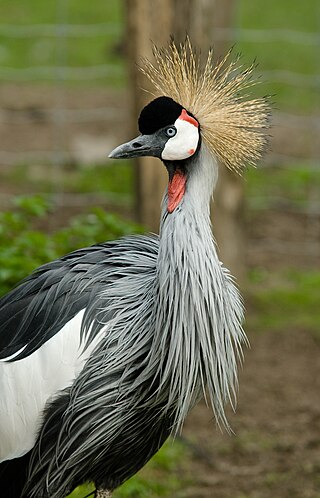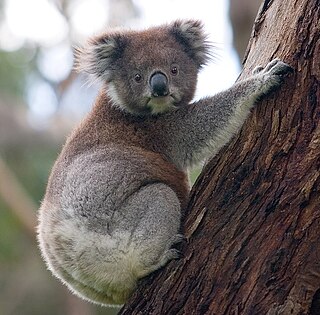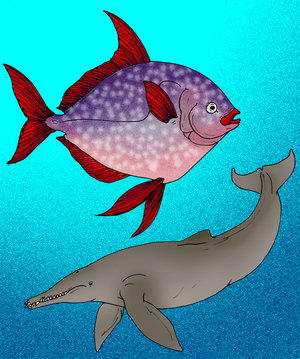
The Gruiformes are an order containing a considerable number of living and extinct bird families, with a widespread geographical diversity. Gruiform means "crane-like".

The Phascolarctidae is a family of marsupials of the order Diprotodontia, consisting of only one extant species, the koala, and six well-known fossil species, with another six less well known fossil species, and two fossil species of the genus Koobor, whose taxonomy is debatable but are placed in this group. The closest relatives of the Phascolarctidae are the wombats, which comprise the family Vombatidae.

The Vombatiformes are one of the three suborders of the large marsupial order Diprotodontia. Seven of the nine known families within this suborder are extinct; only the families Phascolarctidae, with the koala, and Vombatidae, with three extant species of wombat, survive.

Nothofagus, also known as the southern beeches, is a genus of 43 species of trees and shrubs native to the Southern Hemisphere in southern South America and east and southeast Australia, New Zealand, New Guinea, and New Caledonia. The species are ecological dominants in many temperate forests in these regions. Some species are reportedly naturalised in Germany and Great Britain. The genus has a rich fossil record of leaves, cupules, and pollen, with fossils extending into the late Cretaceous period and occurring in Australia, New Zealand, Antarctica, and South America.

Crocodylus is a genus of true crocodiles in the family Crocodylidae.

Paraceratherium is an extinct genus of hornless rhinocerotoids belonging to the family Paraceratheriidae. It is one of the largest terrestrial mammals that has ever existed and lived from the early to late Oligocene epoch. The first fossils were discovered in what is now Pakistan, and remains have been found across Eurasia between China and the Balkans. Paraceratherium means "near the hornless beast", in reference to Aceratherium, the genus in which the type species P. bugtiense was originally placed.

Megistotherium is an extinct genus of hyaenodont belonging to the family Hyainailouridae that lived in Africa.

Borhyaenidae is an extinct metatherian family of low-slung, heavily built predatory mammals in the order Sparassodonta. Borhyaenids are not true marsupials, but members of a sister taxon, Sparassodonta. Like most metatherians, borhyaenids and other sparassodonts are thought to have had a pouch to carry their offspring around. Borhyaenids had strong and powerful jaws, like those of the unrelated placentalians Hyaenodon and Andrewsarchus, for crushing bones. Borhyaenids grew up to an average of 5 to 6 feet long.

Waipatia is an extinct genus of odontocetes from the late Oligocene (Chattian) of New Zealand.
Kamoyapithecus was a primate that lived in Africa during the late Oligocene period, about 24.2-27.5 million years ago. First found in 1948 as part of a University of California, Berkeley expedition, it was at first thought to be under a form of Proconsul by C.T. Madden in 1980, but after a re-examination by Meave Leakey and associates later, the fossils were moved under a new genus Kamoyapithecus, named after the renowned fossil finder Kamoya Kimeu. The genus is represented by only one species, K. hamiltoni.
Kahawamys is an extinct genus of thryonomyoid rodent which existed in Nsungwe Formation, Tanzania during the late Oligocene. It was first named by Nancy J. Stevens, Patricia A. Holroyd, Eric M. Roberts, Patrick M. O'connor and Michael D. Gottfried in 2009 and the type species is Kahawamys mbeyaensis.
Tanzanonautes tuerkayi is a species of fossil freshwater crab from Tanzania, the only species in the genus Tanzanonautes. It is the oldest known freshwater crab, and probably dates from the Oligocene; the next oldest specimens are from the Miocene. A number of fragmentary remains were discovered in the Songwe Valley part of the East African Rift in Mbeya Region, Tanzania, in fragile sandstone sediments. The animal had a carapace around 50 millimetres (2.0 in) across the widest part, which is around 15 mm (0.6 in) from the front of the carapace; the carapace is 44 mm (1.7 in) from front to back, and the slightly inward-curving rear edge of the carapace is 28 mm (1.1 in) across. The genus name refers to Tanzania, the country where the fossil was found, while the specific epithet commemorates Michael Türkay, an authority on freshwater crabs. The genus Tanzanonautes is assigned to the family Potamonautidae, although the characters mentioned in the family's diagnosis are missing from the fragmentary fossils available.

Cymatoceras is a wide-ranging extinct genus from the nautilitacean cephalopod family, Cymatoceratidae. They lived from the Late Jurassic to Late Oligocene, roughly from 155 to 23 Ma.
Mauicetus is a genus of extinct baleen whale from the Late Oligocene of New Zealand.
Microcetus is a genus of extinct odontocete from the late Oligocene (Chattian) of Nordrhein-Westfalen, Germany.
The Nsungwe Formation is a formation in the Rukwa Rift Basin of the East African Rift System, it is Oligocene in age based on U-Pb dating of a tuff horizon within the formation. It is part of the Red Sandstone Group along with the uncomfortably underlying Mid-Cretaceous Galula Formation It is divided into two members, the lower Utengule Member, and the upper Songwe member. It is notable for being one of the most important Paleogene fossil deposits in Sub-Saharan Africa.
Taubatherium is an extinct genus of mammal, belonging to the order Notoungulata. It lived during the Late Oligocene, in what is today Brazil, in South America.

Apterodontinae is an extinct subfamily of hyainailourid hyaenodonts that lived in Africa and Europe during the late Eocene to middle Oligocene.

Hyainailourinae ("hyena-cats") is an extinct subfamily of hyainailourid hyaenodonts that lived in Africa, Asia, North America and Europe from the middle Eocene to middle Miocene. They appeared in Africa about 47.8 Ma ago and soon after spread as far as East Asia.
Rukwasengi is an extinct genus of myohyracine that inhabited Tanzania during the Oligocene epoch. It contains a single species, Rukwasengi butleri.










